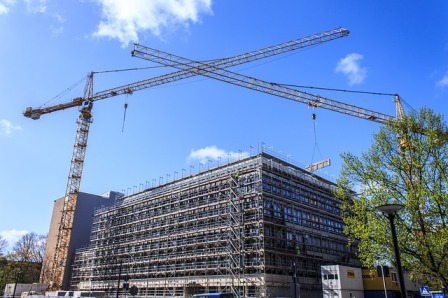NYC Workers Should Arm Themselves With Knowledge About Cranes

When this blog and other sources report on crane accidents, the tendency is to lump them all together. Often the reason for that is how serious the consequences or even potential consequences associated with crane accidents tend to be. Not surprisingly, not all cranes and crane accidents are the same. Numerous types of cranes are used for different reasons and the phrase “crane accident” doesn’t really describe the variations in accidents related to the type of crane.
Types of Cranes
Commonly used crane types include:
- Tower cranes, previously known as balance cranes (further subdivided into mobile cranes, self-erecting tower cranes, top slew tower cranes, saddle job cranes, flat top cranes and luffing tower cranes)
- Tracked crawler cranes
- Dockyard cranes
- Vehicle-mounted cranes
- Rough terrain cranes
- Arial cranes (also known as “sky cranes”)
- Overhead cranes (usually used in factories or warehouses to move loads)
- Sidelifter cranes
- Floating cranes
- Telescopic cranes
- Loader cranes
Each of these cranes is used for a specific purpose: construction of tall buildings, lifting heavy loads, building bridges, moving items around factories, etc. Each also requires different preparation and planning as well as trained manpower to complete the job properly and safely.
Causes and Types of Crane Accidents
Crane accidents don’t happen very often, but when they occur, the consequences are usually significant – serious injury, death and extensive property damage. Crane accidents usually draw a fair amount of news attention that focuses on them because of the potential perils. In fact, a crane accident that does not cause serious injury or death is news in itself. For example, when a crane dropped a multi-ton air conditioner onto Madison Avenue in Manhattan, one of the first sentences in news reports was that no one suffered serious injury. The accident, nonetheless, was splattered all over the news media and internet.
Crane accidents can be broken down into different types, including those listed here:
- A crane touching powerlines, causing electrocution and injury
- A crane overturning or collapsing, usually the result of an improperly secured load, an excessive load or uneven ground
- Improper assembly and take-down
- Inadequate communication between supervisor and crane operator
- Crane malfunction
- Inadequate training of crane operators
- A crane dropping its load because the hoisting mechanism is faulty or the load is too heavy
- A crane boom swinging and hitting people or material
- Wind
Cranes touching power lines is the most common cause of crane accidents, according to the Occupational Safety and Health Administration (OSHA) and other sources.
New York City Crane Accidents
It is not surprising that the New York City construction boom of the past few years has resulted in a few additional crane accidents. It has also resulted in the entry of nonunion contractors into the marketplace. Cynics claim the nonunion businesses produce an inferior product and are less committed to safety. These contractors tend to skimp on safety and training, making their employees more vulnerable to construction accidents of all kinds, including crane accidents, opponents claim. While we are not here to take a stance on union versus nonunion work, we can all agree that the increase in construction has led to a significant increase in serious construction and crane accidents.
New York City crane accidents reported in 2015 include:
- A crane dropped a multi-ton air conditioner onto the street as it was being lifted into a building under construction. It is thought that the air conditioner was improperly secured. The crane operator and owner, Skylift Contractor Corp. and Bay Cranes, have both had safety problems in the past. Ten pedestrians on the street were injured.
- A crane safety coordinator was killed on a Second Avenue construction site when he was checking a hydraulic problem with the mini-crane used at the site. The problem apparently caused the arm to fall, pinning the man between the crane arm and the truck.
Of course, New York City is not the only place where crane accidents occur. Just in the first few weeks of September 2015, the website www.craneaccidents.comreported on these incidents in:
- Dayton, Ohio (An operator was injured when a rough terrain crane overturned.)
- Mecca, Saudi Arabia (At least 75 died and hundreds were injured when a luffing jib tower crane collapsed.)
- Smithfield, Rhode Island (Six men were injured and other cranes crushed when a truck crane collapsed.)
- Kuala Lumpur, Malaysia (Two men were injured when the jib of a tower crane fell onto them.)
Preventing Crane Accidents
OSHA has discussed the issue of crane safety in many publications and training materials. It offers tips to prevent crane accidents that include:
Have a qualified inspector examine the crane before each use.
- Establish a regular inspection schedule to identify less obvious defects, such as worn out wires and ropes.
- Use only qualified people to make repairs.
- Cranes should always be on flat ground and at least 10 feet away from any electric wires.
- Avoid the temptation to have a crane carry a load heavier than its capacity.
- Erect fencing around construction sites to protect passersby from collapsing cranes and other falling objects.
- Always have a spotter or signal person to help move loads from one place to another.
- All workers, including crane operators, should have fall protection systems when working more than six feet above ground.
- Pay attention to the wind, which OSHA reports as being one of the leading causes of crane accidents.
The number of crane accidents could be reduced by following these steps. Owners and operators need to create a work environment that promotes safety. Without this, crane accidents will continue to occur.

